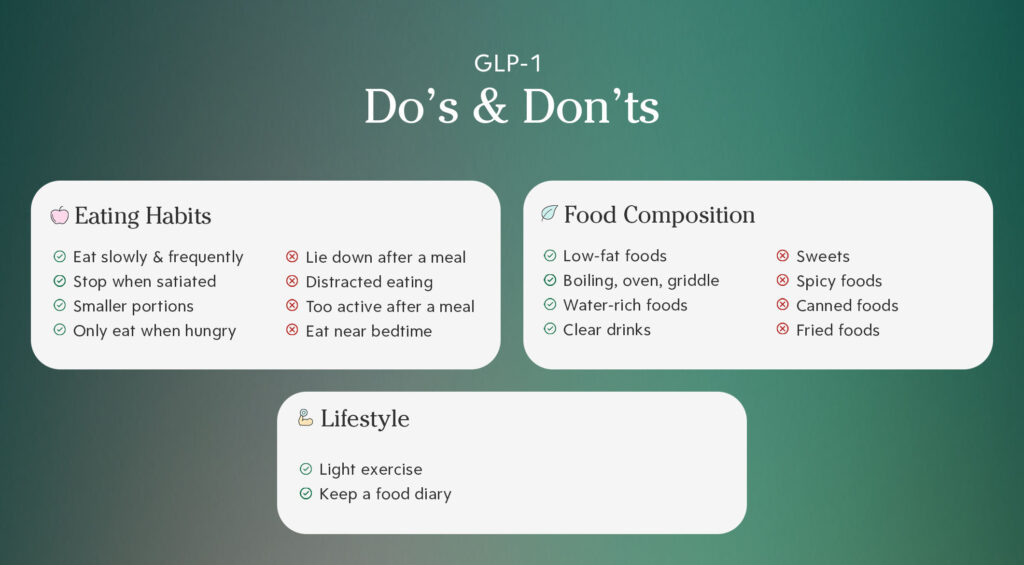
Here’s what we’ll cover in this blog post:
- Best diet for Semaglutide side effects
- Best exercise for Semaglutide side effects
- When to ask for your doctor’s help
- Common OTC medications to relieve discomfort
Whether you know it as Ozempic®, Wegovy®, or Compounded Semaglutide, Semaglutide has become popular among healthcare providers and patients due to its ability to regulate blood sugar levels and reduce appetite.
However, Semaglutide side effects—like nausea, vomiting, diarrhea, and constipation—can make some hesitant to start their Semaglutide journey.
Luckily, there are simple solutions to many Semaglutide side effects. Here, we’ll explore how you can relieve some of these symptoms, so you can achieve the best results.

Dietary Changes to Alleviate Gastrointestinal Symptoms
Food plays a huge role in our lives, and that’s especially true with Semaglutide.
While you’re taking Semaglutide, opt for smaller, more frequent meals to keep nausea at bay. Prioritize low-fat, easy-to-digest foods to minimize any gastrointestinal discomfort.
Keep in mind, too, that what you don’t eat is just as important as what you do eat. Avoid greasy, high-fat options and go for fresh fruits and vegetables and lean protein. If you’re feeling nauseous, try plain broth or crackers.
The Role of Physical Activity in Managing Side Effects
Getting some exercise can do wonders for Semaglutide side effects.
Regular, moderate physical activity can help alleviate constipation, regulate digestion, and soothe general gastrointestinal discomfort. If you prefer lower impact exercise, rest assured that any exercise is a step in the right direction. So, whether it’s a brisk walk or a yoga session, staying active is a plus.
Navigating Nausea: Practical Tips and Tricks
Nausea doesn’t have to be a constant companion on your Semaglutide journey. Simple adjustments to your eating habits, such as avoiding large meals and incorporating ginger into your diet, can offer relief.
Remember, it’s also okay to seek help from your healthcare provider if your nausea persists. Your doctor can recommend medications to relieve your nausea without compounding your discomfort.
The Importance of Staying Hydrated
Drinking plenty of fluids is crucial, especially when dealing with gastrointestinal side effects.
However, Semaglutide can make you feel fuller faster, making it challenging to meet your hydration needs. Staying hydrated can help not only to relieve gastrointestinal side effects, but it can also prevent constipation and decrease headaches.
The key is to sip small amounts of water or clear liquids throughout the day to keep hydration levels optimal. You should also try to keep dehydrating beverages like alcohol or caffeine to a minimum.
Monitoring and Adjusting Dosages with Professional Guidance
Semaglutide isn’t a one-size-fits-all medication. Working closely with your AgelessRx healthcare provider to adjust the dosage can make a significant difference in how you tolerate treatment. They can guide you through any necessary adjustments to find a balance that minimizes side effects while maximizing benefits.
When to Reach for Medication
Sometimes, Semaglutide side effects can stubbornly persist, even with proper diet, hydration, and exercise. It’s essential to recognize when it’s time to consider medication to manage these side effects. Here’s how to know when lifestyle changes aren’t cutting it:
- Persistent Symptoms
If you’ve faithfully followed dietary and lifestyle advice but still find yourself grappling with ongoing nausea, vomiting, diarrhea, or constipation, it might be time to explore medicinal options. - Impact on Daily Life
When side effects start to interfere with your usual routine or affect your nutritional intake significantly, reaching out for medical assistance is critical.
- Lack of Improvement Over Time
Side effects may sometimes stay the same or even worsen as treatment continues. This plateau or decline in symptom management is a clear signal to consider additional interventions with your doctor.
Common Medications for Semaglutide Symptoms
If lifestyle adjustments aren’t sufficient, several medicinal options can help manage side effects. However, these should always be pursued under the guidance of your healthcare provider.
- For Nausea and Vomiting:
Antiemetic medications can provide relief. Drugs such as ondansetron have been effective for some patients, but they come with their own set of potential side effects and interactions. - For Diarrhea:
Over-the-counter options like loperamide (Imodium) can offer immediate relief. However, it’s crucial to ensure that the use of such medications doesn’t mask underlying issues that need medical attention.
- For Constipation:
Over-the-counter stool softeners or mild laxatives like psyllium (Metamucil), Docusate sodium (Colace), or polyethylene glycol (MiraLAX) can help relieve constipation symptoms.
Taking the Next Steps
By making thoughtful lifestyle changes, staying in close communication with your healthcare provider, and maintaining a healthy lifestyle, you can navigate Semaglutide side effects with confidence and start enjoying better quality of life—not to mention the benefits of Semaglutide!
If you find yourself reaching the point where medication seems necessary, reach out to your AgelessRx Team. Together, we can review your symptoms, discuss your current lifestyle strategies, and determine the best course of action.
With the right approach, you can navigate the challenges of Semaglutide side effects and continue your path to better health with confidence.
Note: The above statements have not been evaluated by the Food and Drug Administration. This product is not intended to diagnose, treat, cure, or prevent any disease.
FAQs
How common are Semaglutide side effects?
The incidence of Semaglutide side effects varies per symptom. GoodRx reports that nausea is the most common side effect, with up to 20% of users reporting nausea in clinical trials. Vomiting or diarrhea were reported by about 9% of users, while abdominal pain was reported by 6-7% of users, and constipation by 3-5% of users.
What are the most common side effects of Semaglutide?
The most common side effects of Semaglutide include nausea, vomiting, diarrhea, stomach, pain, constipation, and general gastrointestinal discomfort. These symptoms are most often reported by users in clinical trials, but they aren’t the only possible side effects of Semaglutide. For a more complete list of Semaglutide side effects, please see the Mayo Clinic’s Semaglutide resources.
How long until Semaglutide side effects go away?
Common Semaglutide side effects often last for a few days, but may last for up to a few weeks. Side effects normally go away on their own in this time frame.
